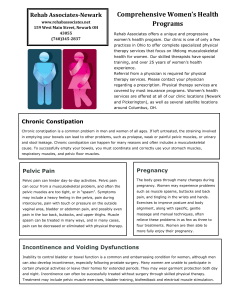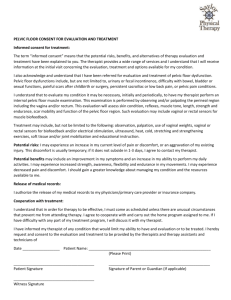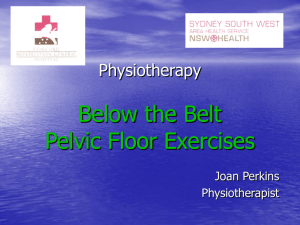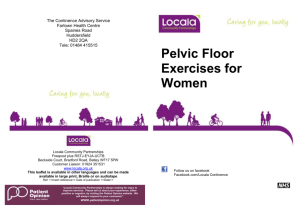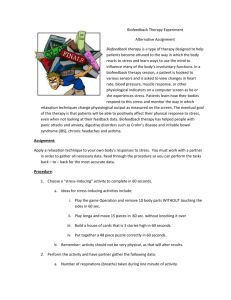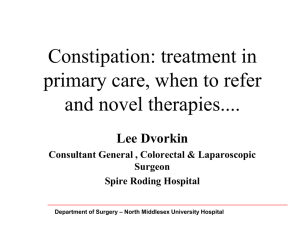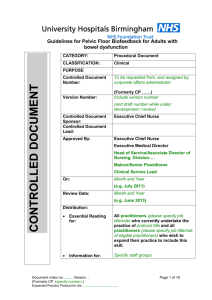Biofeedback therapy in pelvic floor disorders
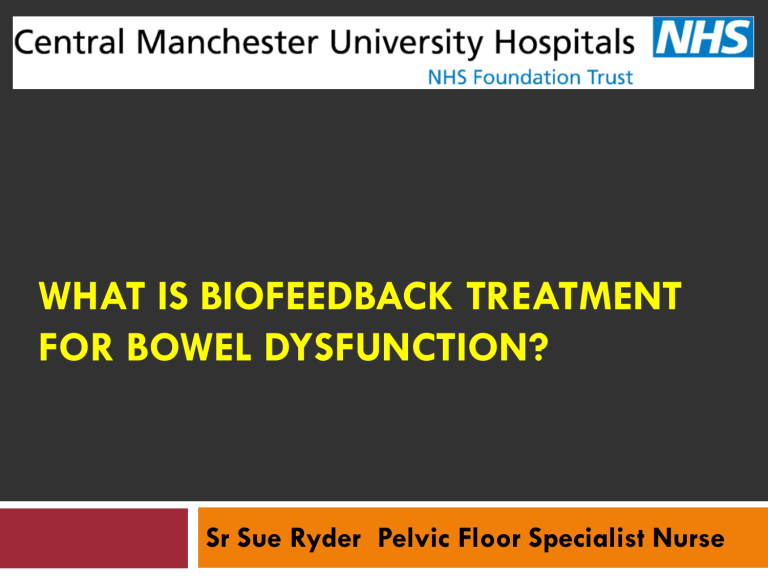
WHAT IS BIOFEEDBACK TREATMENT
FOR BOWEL DYSFUNCTION?
Sr Sue Ryder Pelvic Floor Specialist Nurse
Assessment is so important
Patients with Bowel dysfunction require an extensive assessment to establish a diagnosis, highlight key points that help the health professional plan the most suitable treatments and management strategies
Appointments 1 hour (or more sometimes) make time to get the whole picture, discuss relevant investigation results, previous strategies and why they failed
Patients fill in at home a 6 page detailed bowel assessment form - they often add an essay as they have the time
Complete a 7 day diet and bowel diary
What is Biofeedback Treatment?
Pelvic floor biofeedback therapy is a type of physical therapy that can help men and women to learn how to contract and relax the pelvic floor muscles.
It is used for patients who have bladder and/or bowel incontinence, difficult defaecation caused by abnormal pelvic muscle contraction and pelvic floor dysfunction.
Patients attend between 3-6 sessions, 1 a month for 3-5 months with a therapist (Specialist Nurse/ Physio/
Physiologist who is specially trained in pelvic floor therapy.
How does pelvic floor biofeedback therapy work?
Pelvic floor biofeedback therapy works by training the brain and pelvic muscles to work together to tighten and relax the pelvic floor muscles.
Sensors in the vagina or rectum measure the contraction and relaxation of the muscles and patients get visual cues on a computer monitor so that they can learn to better use these muscles.
In many cases patients have tried pelvic floor exercises without success, but they have not been contracting the correct muscles or they have been contracting them incorrectly. Many patients symptoms improve following structured pelvic floor biofeedback therapy.
Sensory biofeedback
Digital vaginal examination/ palpation
Vaginal cones/weights/ Amielle dilators
Digital rectal examination
Rectal dilators
Relaxation biofeedback
Teach anal sphincter, pelvic floor and abdominal muscle relaxation
Focus on importance of calm taking your time STOP RUSHING AROUND
Teach diaphragmatic and abdominal breathing exercises (practice one now)
Pressure biofeedback
Perineometry
Rectal balloons assess onset, urge and maximum rectal sensation using millilitre's mls of air.
Assess and record both abdominal and rectal propulsion, none, weak, poor, strong etc
Then we teach correct abdominal brace and bulge technique
Patients are then to practice this each defaecation to improve abdominal-anorectal co-ordination
Ultrasonic biofeedback
Trans abdominal ultrasonography
Post void bladder scanning
Electromyographic EMG biofeedback
Electromyographic EMG biofeedback
Biofeedback units generally provide either visual or auditory feedback relative to the quantity of electrical activity - which is measured in Microvolts μ V
Visual feedback uses lights, bars, analogue or digital measurements
Auditory feedback uses increasing or decreasing tones, buzzing, beeping or clicking
S(SURFACE) EMG Recordings
S EMG signal analysis
Baseline or resting level: the level of SEMG when the muscle is totally relaxed. It is generally accepted that the SEMG of a muscle at rest should be below 5 μ V.
Averaged contraction (mean of SEMG during contraction): this is a good indicator of the level of muscle strength and endurance (while performing an isometric contraction).
Peak or maximum : this is the maximum SEMG amplitude the muscle can generate.
Variability : is a good indicator of the neuromuscular stability.
SEMG signal analysis
SEMG unhealthy muscle
The resting level is too high
The level of contraction is very low
The muscle shows instability
SEMG healthy muscle
Resting level is low
onset and release are quick
and the contraction is high
Biofeedback progress report
Rectum & Anal Canal
Stores waste material
Rectum wider in diameter -approx
15cm length
Absorbs water & electrolytes 500-
2000mls per day
Habitat for micro-organisms - e coli
Anal canal 2 – 6 cm
Anal canal has a very important role in the maintenance of faecal continence (valve)
It controls rectal emptying
Surrounded by two sphincter mechanisms -Internal & External
Internal IAS & External EAS anal sphincters
IAS contributes significantly to resting pressure of anal canal 80%
IAS has continuous electrical activity (tonically contracted)
IAS has reduced activity with rectal distension (rectoanal inhibitory reflex)
EAS is striated muscle innervated pudendal nerve
EAS Voluntary contractable, relaxable & fatigable
Rectal distension results in increased EAS activity helps maintain continence during internal anal sphincter relaxation
Anorectal sensation and sphincter function during defaecation
Contents progressively fill rectum
Critical level of filling triggers conscious perception
EAS contracted (sub-conscious) as IAS begins to relax
Appropriate social context sought (conscious!) and await next giant migrating peristaltic contraction
IAS remains relaxed; EAS now relaxes
Bolus further relaxes EAS by traction
After voiding EAS snaps shut
Normal Defaecation
Needs higher than hips
Lean forward and put elbows on knees
Bulge abdomen
Straighten spine
Pelvic Floor Muscles
In the rectum the Pelvic Floor Muscles
(Levator ani, Puborectalis) regulate faecal retention & defecation
Puborectalis suspends the rectosigmoid junction like a sling and facilitates voluntary stool retention
Puborectalis and EAS must both voluntary relax, pelvic floor muscles descend to straighten anorectal angle for defaecation
Puborectalis sling
Female pelvic floor muscles
Male pelvic floor muscles
Importance of Pelvic Floor & anal sphincter exercises
Prevents urinary and faecal incontinence
Exercises increase strength and tone
Increases blood flow which increases lubrication
Increases sexual pleasure, prevents erectile dysfunction
Prevents genital prolapse
Supports spine and controls abdominal pressure
Other elements to Biofeedback
It’s a step up programme
Always start with the basic advice (don’t presume they’re done it) only when that’s tried and failed step up…
I ALWAYS RE-ITERATE IMPORTNCE TO
KEEP ON BASIC STEPS AS WE PROGRESS
UP
1.
A healthy balanced diet 3 meals a day, good neutral fluid intake and some weekly exercise – yoga, pilates or just a bit of walking if unfit
Lifestyle and Dietary Advice Fibre Content of Foods
• General recommendations
• Dietary fibre:
18 to 30 g per day.
• Fluid intake:
1.5 to 2 litres per day.
• Fruit and vegetables:
5 portions per day.
Soluble and Insoluble Fibre
Plants have both, classified by the higher level
Soluble – fruit, veg, pulses, oats, beans, barley, seeds
Insoluble – fruit & veg with skins & pips, wholegrain cereals (wheat, rye, rice), nuts & some pulses, seeds
Insoluble fibre in particular acts like a sponge absorbs water increases stool weight and size and without fluid cannot do its job and will result in constipation
Soluble fibre dissolves in water to form a gel like material as it passes through the gut, gentler for IBS patients
Benefits of fibre in your daily diet
Normalises bowel movements
Helps maintain bowel health
Lowers cholesterol levels
Helps control blood sugar levels
Aids in achieving healthy weight
Prevents colorectal cancer
Exercise
It is important to try and exercise regularly but don’t overdo it.
You should aim for 30 minutes of moderate activity at least five times a week.
It helps to vary the type of exercise that you. Try different activities such as swimming, walking, aerobic activities and Pilates, and yoga.
Avoid activities that suddenly increase your intraabdominal pressure such as high impact aerobics or jogging/running.
Review medication
List everything down and their over the counter meds
Do they work?
Do they have side effects that affect your bowel?
If they are necessary consider a safer and gentler alternative – they can discuss this with their GP
Most people can cut out a lot of their medication
Normalise stool consistency
What is your bowel frequency?
Do you have a pattern?
What is your stool consistency?
Only when dietary and soluble fibre supplements have been tried for a good period but aren’t working consider:
Laxatives
Loperamide
Psychological Factors
Feeling ‘up tight’
Anxiety and depression
Type A personalities
Busy v sedentary lifestyle
Ignoring ‘call to stool’
Going to often just to try
Stress
Wanting to go when suits them not their bowel
Peristeen Rectal Irrigation BY COLOPLAST
Indications
Neurogenic bowel dysfunction
e.g. spinal cord injury, spinal bifida, multiple sclerosis.
Bowel dysfunction
Chronic/slow transit constipation
Evacuation difficulties.
Chronic faecal incontinence.
With success rates of 50-90%
PTNS Percutaneous Tibial Nerve
Stimulation Treatment
BY UROPLASTY
Urgent ® PC Neuromodulation System
The Urgent PC System is a simple, safe and effective, outpatient method of treating urinary urgency, urinary frequency and urge incontinence.
Urgent PC is also indicated for the treatment of faecal incontinence. With success rates of 60-80% , this simple, non-surgical treatment is effective, lowrisk and associated with minimal sideeffects. The Urgent PC System consists of the Urgent PC Stimulator and the
Urgent PC Lead Set.
Sacral Nerve Stimulation
BY MEDTRONIC
The InterStim TM neurostimulator is a surgically implanted device that stimulates your sacral nerve with mild electrical pulses. The sacral nerve controls your bladder and bowel and the muscles related to pelvic floor function.
With success rates of 70-90%
Neuromodulation can eliminate the symptoms of overactive bladder, including urge incontinence, urgencyfrequency, and urinary retention , constipation, pelvic pain and faecal incontinence.
MY LOVES & HATES
<3 Golden Linseeds, good fluid intake, healthy diet
<3 Patients that read our leaflets and practice our recommendations - its only 5 minutes three times a day and when their on the toilet
Opiates, polypharmacy (often not required just sometimes to treat each others side effects)
Patients that expect surgery to miraculously cure all ailments, if only we could do that!
My conclusion >12 years of Biofeedback
Patient assessment and education with conservative management strategies should be first line treatment
EMG is safe, effective, painless and well tolerated. It provides significant additional benefits for some bowel symptoms
But it’s when all the elements of Biofeedback treatment discussed today are put together like a jigsaw that patients symptoms & QOL finally improve
You need a motivated patient and skilled practitioner for it to work!
With success rates between 40-75%
Educating your patients about everything affecting their bowel problem is vital to help them improve their symptoms and manage better
THANKS FOR LISTENING ANY QUESTIONS?
Sue Ryder
40
Sue Ryder March 14
Advanced PC Muscle Training by
Tatyana Kozhevnikova
http://www.youtube.com/watch?v=T-k6-3Sfk1g
So far this has over 700,000 hits
